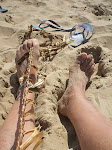 |
| Ewen Balfour working with the children at Urufirth |
This summer Stephanie, along with Dawn Susan, Julie Gurr and Liz Balfour, has been visiting Museums in the Highlands and Islands, documenting objects meeting elders and organising events.
The Shetland Museum was one of the partner organisations and Ian Tait, the Director of the Shetland Museum, invited myself and Ewen Balfour to be involved in the Woven Communities activities that were being organised by Kirsty and Yvonne, the Museums Education team, in Shetland schools. I happily accepted, though not without some trepidation, because it has been a while since I have done any work in schools.
 |
| Simmens 'makkin' at Urufirth |
In the end the programme that was divised between us all worked well. Ian started with a talk about the Shetland basketry tradition, this was followed by Ewen who taught the pupils how to make simmens (rope) with floss ( Juncus effusis) and then showed them how the simmens were used for making kishies. Stephanie told the children about the Woven Communities Project and it was my task to re-enforce the simmens making, but with bits of found ghost rope pieces, that we then tied or stitched into baskets. Stephanie documented the activities in all the schools on video.
 |
| Whalsay pupils and their baskets made from found materials |
Locals were invited to come in with any baskets that they had at home and in Unst we had several visitors come to the school with lovely kishies.
 |
| Child size kishies made some years ago on Unst |
My co-workers, the schools, their teachers and the children were all a pleasure to work with and seemed to genuinely enjoy their immersion. A session at Urufirth was made very special by the children bursting into spontaneous singing, whilst working.
If we do not work with children we cannot expect any of these traditional skills to survive. So for me it was a positive and rewarding experience to know that as a result of this project at least 30 children aged between 7 and 13, who knew little or nothing about the tradition of basket making in Shetland, now know a lot more and are capable of making a small coiled basket and simmens in various materials.
For those interested there is a second Woven Communities symposium being organised by Stephanie at St. Andrews for January 2017. Details will be being published soon, so check the Woven Communities Facebook page if you are interested in attending.

































